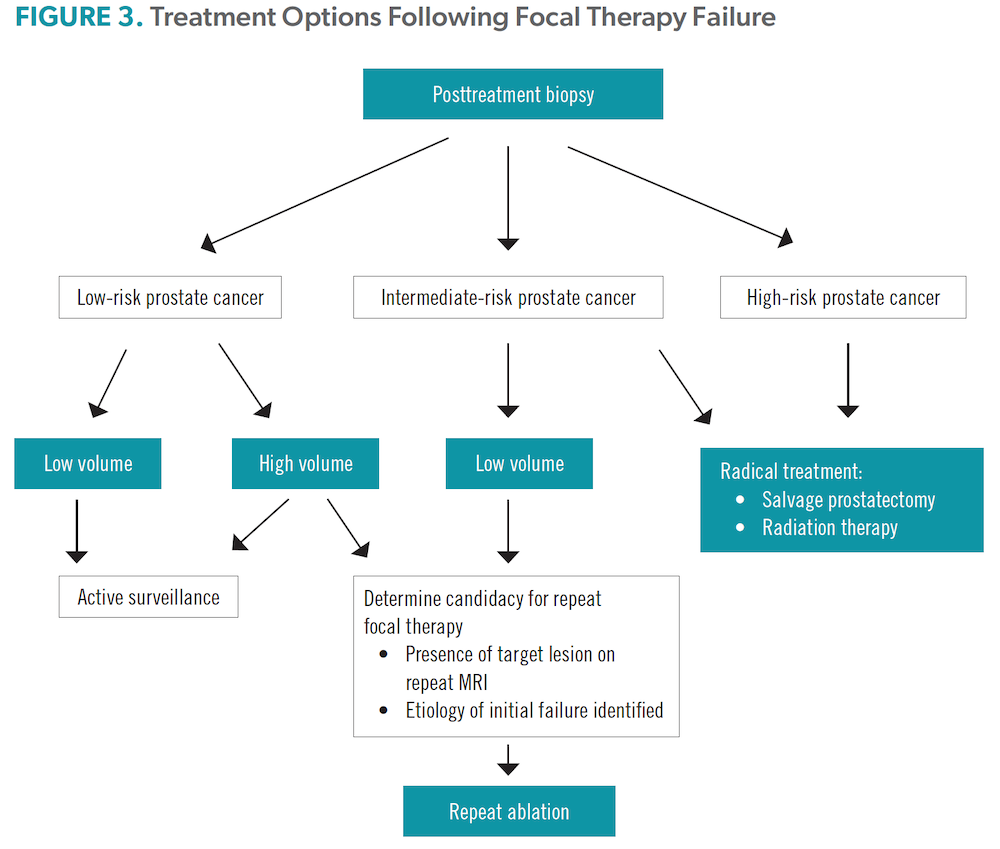Everyone with cancer worries at some level that it might come back after primary (first) treatment. There is the natural fear of the disease itself, but there’s also a mix of accompanying anxieties. A big one concerns the choice of secondary, or salvage, treatment if the primary treatment didn’t work.
While these fears are more intense if the original tumor was aggressive, this is not necessarily the case with prostate cancer (PCa). First, most PCa is found when it is still low-to-intermediate risk and confined within the gland—treatment success rates without recurrence are high! Second, we now know that at least 1/3 of PCa tumors are unifocal (found in only one location) so they are amenable to a focal therapy such as our Focal Laser Ablation (FLA).
Focal treatment leaves all salvage options open
For carefully qualified patients, FLA is an MRI-guided precision treatment that accurately ablates (destroys) a focal PCa tumor. FLA has four especially attractive aspects:
- It obliterates the known tumor, which is a comfort for patients who are candidates for Active Surveillance but don’t like the idea of PCa growing in their body.
- The tumor is destroyed but there are minimum risks of urinary, sexual or bowel side effects.
- It is repeatable if PCa comes back, either as recurrence due to adjacent microscopic cells undetected at the time of initial FLA, or a new focus of disease elsewhere in the gland.
- If there is recurrence and the patient does not wish to have a repeat FLA, all other options are still open, including Active Surveillance, prostatectomy, radiation/brachytherapy, or focal therapy with a different modality such as HIFU or cryotherapy (freezing).
According to a March, 2021 article by Stratton & Patel[i], a growing number of men are opting for focal treatment, so it’s to be expected that there will be more cases of recurrence. Thus, “Careful consideration of treatment options is important to match the best treatment with the patient’s preferences. Fortunately, patients who have received focal therapy appear to be candidates for all the typical prostate cancer treatments.” That’s good news!
Careful consideration – what does that mean?
As with any malignant tumor recurrence, gaining a thorough diagnostic PCa profile offers the best information for a patient and his doctor to carefully weigh treatment options in order to maximize effective cancer control while preserving a patient’s lifestyle wishes as much as possible.
At our Center, we offer the highest standards in the diagnostic process. Generally, a rising PSA after focal laser ablation—coupled with our multiparametric MRI (mpMRI) detection enhanced by Artificial Intelligence—will be the earliest knowledge of possible recurrence. If mpMRI reveals a tumor, we perform a real time in-bore MRI-targeted biopsy, using minimal needles to capture the most strategic PCa cells. Our biopsy samples are then professionally evaluated to determine the true degree of aggressiveness and, if indicated, they can be further genomically analyzed.
Stratton & Patel cite an easy-to-follow decision (Aminsharifi, et al, 2019[ii]). As you see in the diagram below (labeled FIGURE 3 in Stratton & Patel), it begins after a suspicious recurrence has been detected and then biopsy-diagnosed as positive for PCa. Depending on the diagnosis (low, intermediate, or high risk PCa), the arrows navigate to suggested treatment matches, including a repeat ablation:
Of course, not every case neatly fits into the above categories. A tailored treatment plan might include, for instance, a course of androgen deprivation therapy to reduce tumor size. However, the diagram shows there’s no need to panic since there are multiple solutions for cases of recurrence after FLA or other focal treatment. In fact, our Center offers the three most advanced focal treatment methods: FLA, TULSA-PRO, and Exablate MRgFUS. At our Center, our recurrence rates are very low—but should suspicion arise, we work with each individual for optimum diagnosis and best treatment option(s). We are grateful to Stratton & Patel for bringing this reassuring model to everyone’s attention.
NOTE: This content is solely for purposes of information and does not substitute for diagnostic or medical advice. Talk to your doctor if you are experiencing pelvic pain, or have any other health concerns or questions of a personal medical nature.
References
[i] Stratton KL, Patel v. Management of recurrent prostate cancer after focal therapy. Urology Times, Mar. 9, 2021. https://www.urologytimes.com/view/management-of-recurrent-prostate-cancer-after-focal-therapy
[ii] Aminsharifi A, Polascik TJ. Diagnosis and management of local recurrence after prostate focal therapy: challenges and solutions. Eur Urol Oncol. 2019;2(5):539-540.



